Enterprise Industrial Relations Case Study: Wage and Labor Analysis
VerifiedAdded on 2023/03/30
|5
|837
|319
Case Study
AI Summary
This case study analyzes the differences in wage structures and labor practices between three enterprises: Woolworths, Westpac, and Gordon & Gotch Australia Pty Limited. The analysis highlights the influence of union density, market competition, and stakeholder interests on enterprise agreements. Woolworths, as a labor-intensive retail industry, benefits from strong union representation and a wider market, leading to favorable agreements for its employees. Westpac, a knowledge-based financial institution, demonstrates a competitive wage structure and focuses on long-term responsiveness. Gordon & Gotch Pty, however, faces challenges due to factors like limited growth opportunities. The study examines how these factors, along with varying stakeholder interests, shape the agreements and overall outcomes for each enterprise. The document references several sources, including the Fair Work Commission and academic journals, to support its findings and conclusions.
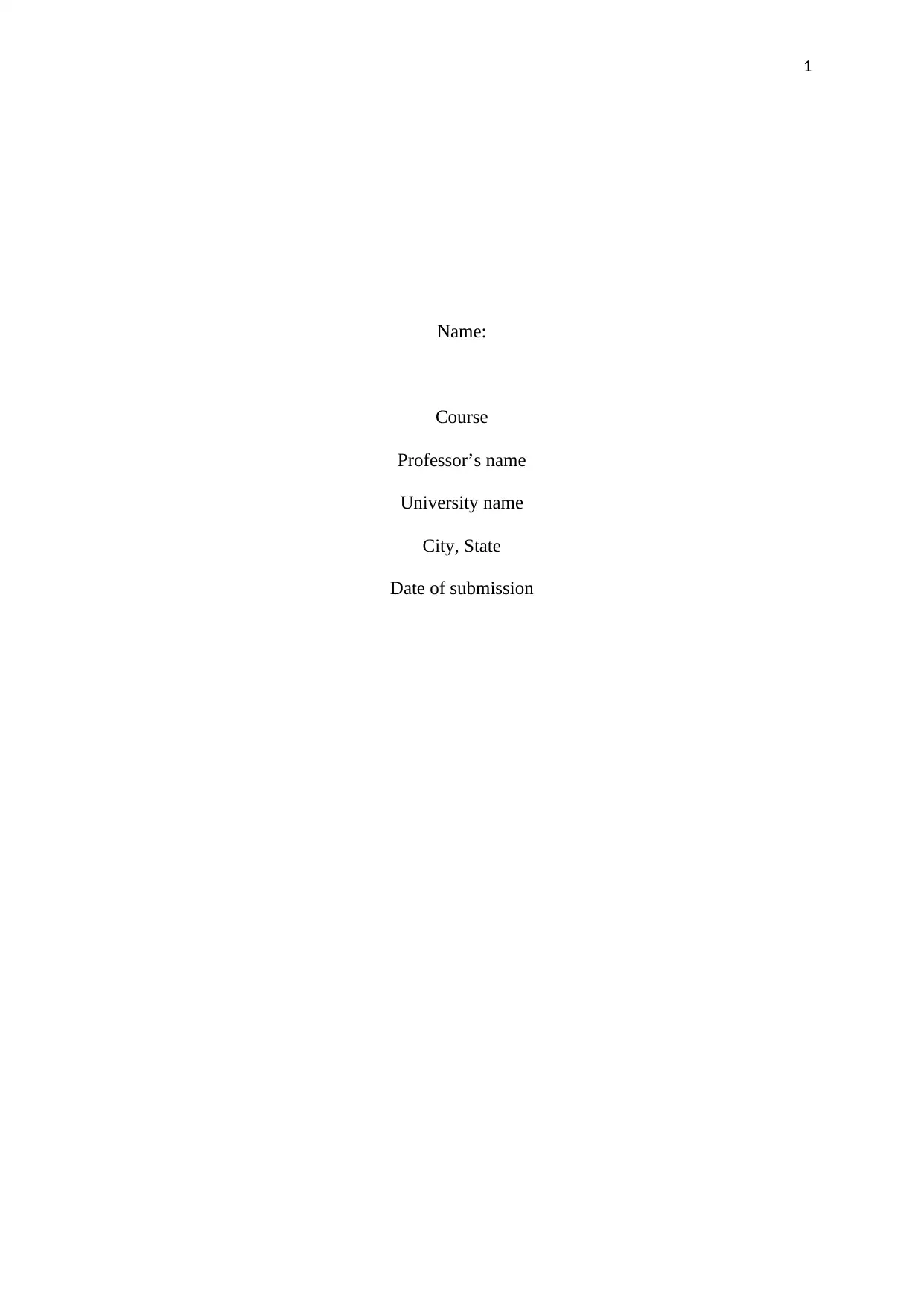
1
Name:
Course
Professor’s name
University name
City, State
Date of submission
Name:
Course
Professor’s name
University name
City, State
Date of submission
Paraphrase This Document
Need a fresh take? Get an instant paraphrase of this document with our AI Paraphraser
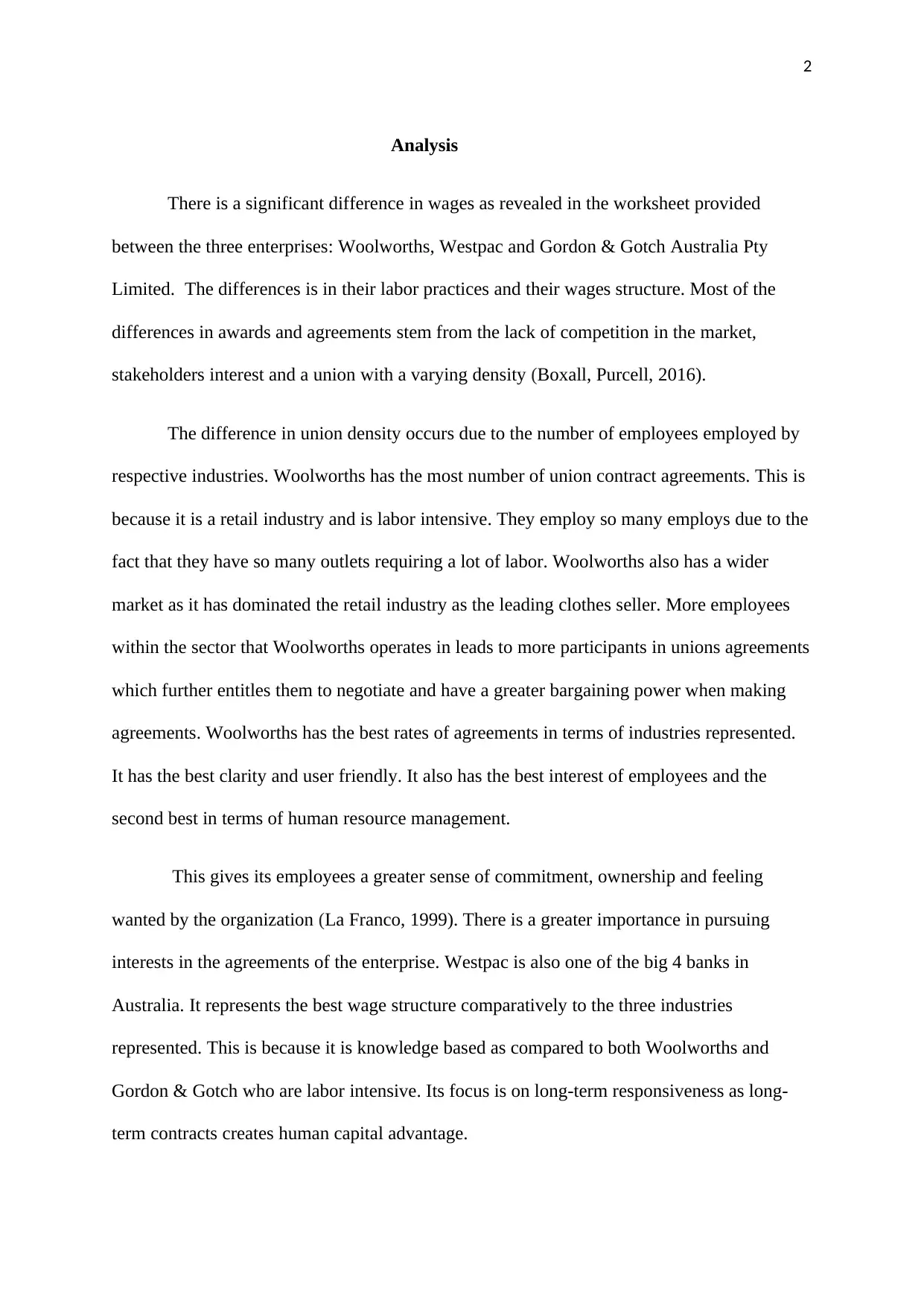
2
Analysis
There is a significant difference in wages as revealed in the worksheet provided
between the three enterprises: Woolworths, Westpac and Gordon & Gotch Australia Pty
Limited. The differences is in their labor practices and their wages structure. Most of the
differences in awards and agreements stem from the lack of competition in the market,
stakeholders interest and a union with a varying density (Boxall, Purcell, 2016).
The difference in union density occurs due to the number of employees employed by
respective industries. Woolworths has the most number of union contract agreements. This is
because it is a retail industry and is labor intensive. They employ so many employs due to the
fact that they have so many outlets requiring a lot of labor. Woolworths also has a wider
market as it has dominated the retail industry as the leading clothes seller. More employees
within the sector that Woolworths operates in leads to more participants in unions agreements
which further entitles them to negotiate and have a greater bargaining power when making
agreements. Woolworths has the best rates of agreements in terms of industries represented.
It has the best clarity and user friendly. It also has the best interest of employees and the
second best in terms of human resource management.
This gives its employees a greater sense of commitment, ownership and feeling
wanted by the organization (La Franco, 1999). There is a greater importance in pursuing
interests in the agreements of the enterprise. Westpac is also one of the big 4 banks in
Australia. It represents the best wage structure comparatively to the three industries
represented. This is because it is knowledge based as compared to both Woolworths and
Gordon & Gotch who are labor intensive. Its focus is on long-term responsiveness as long-
term contracts creates human capital advantage.
Analysis
There is a significant difference in wages as revealed in the worksheet provided
between the three enterprises: Woolworths, Westpac and Gordon & Gotch Australia Pty
Limited. The differences is in their labor practices and their wages structure. Most of the
differences in awards and agreements stem from the lack of competition in the market,
stakeholders interest and a union with a varying density (Boxall, Purcell, 2016).
The difference in union density occurs due to the number of employees employed by
respective industries. Woolworths has the most number of union contract agreements. This is
because it is a retail industry and is labor intensive. They employ so many employs due to the
fact that they have so many outlets requiring a lot of labor. Woolworths also has a wider
market as it has dominated the retail industry as the leading clothes seller. More employees
within the sector that Woolworths operates in leads to more participants in unions agreements
which further entitles them to negotiate and have a greater bargaining power when making
agreements. Woolworths has the best rates of agreements in terms of industries represented.
It has the best clarity and user friendly. It also has the best interest of employees and the
second best in terms of human resource management.
This gives its employees a greater sense of commitment, ownership and feeling
wanted by the organization (La Franco, 1999). There is a greater importance in pursuing
interests in the agreements of the enterprise. Westpac is also one of the big 4 banks in
Australia. It represents the best wage structure comparatively to the three industries
represented. This is because it is knowledge based as compared to both Woolworths and
Gordon & Gotch who are labor intensive. Its focus is on long-term responsiveness as long-
term contracts creates human capital advantage.
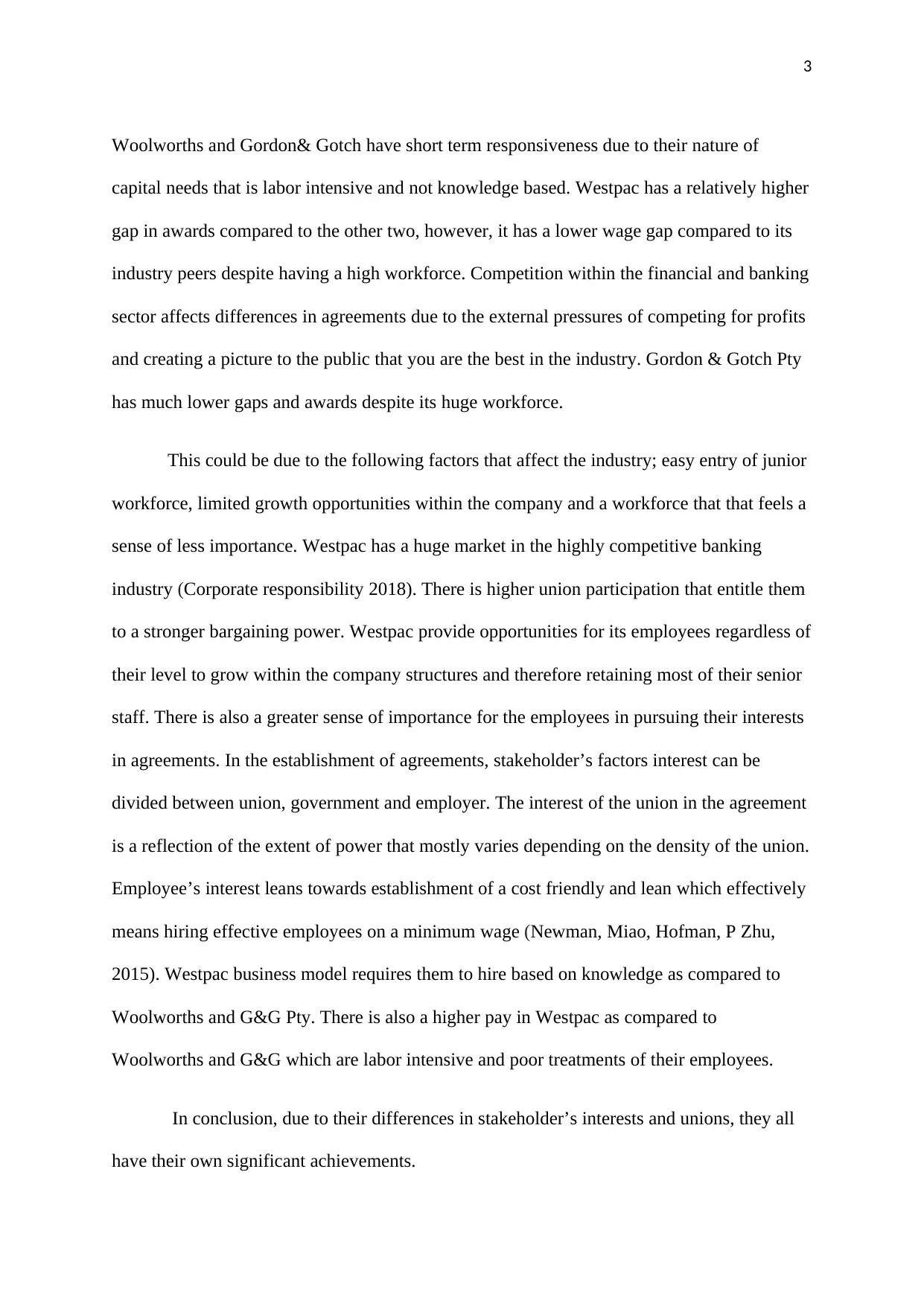
3
Woolworths and Gordon& Gotch have short term responsiveness due to their nature of
capital needs that is labor intensive and not knowledge based. Westpac has a relatively higher
gap in awards compared to the other two, however, it has a lower wage gap compared to its
industry peers despite having a high workforce. Competition within the financial and banking
sector affects differences in agreements due to the external pressures of competing for profits
and creating a picture to the public that you are the best in the industry. Gordon & Gotch Pty
has much lower gaps and awards despite its huge workforce.
This could be due to the following factors that affect the industry; easy entry of junior
workforce, limited growth opportunities within the company and a workforce that that feels a
sense of less importance. Westpac has a huge market in the highly competitive banking
industry (Corporate responsibility 2018). There is higher union participation that entitle them
to a stronger bargaining power. Westpac provide opportunities for its employees regardless of
their level to grow within the company structures and therefore retaining most of their senior
staff. There is also a greater sense of importance for the employees in pursuing their interests
in agreements. In the establishment of agreements, stakeholder’s factors interest can be
divided between union, government and employer. The interest of the union in the agreement
is a reflection of the extent of power that mostly varies depending on the density of the union.
Employee’s interest leans towards establishment of a cost friendly and lean which effectively
means hiring effective employees on a minimum wage (Newman, Miao, Hofman, P Zhu,
2015). Westpac business model requires them to hire based on knowledge as compared to
Woolworths and G&G Pty. There is also a higher pay in Westpac as compared to
Woolworths and G&G which are labor intensive and poor treatments of their employees.
In conclusion, due to their differences in stakeholder’s interests and unions, they all
have their own significant achievements.
Woolworths and Gordon& Gotch have short term responsiveness due to their nature of
capital needs that is labor intensive and not knowledge based. Westpac has a relatively higher
gap in awards compared to the other two, however, it has a lower wage gap compared to its
industry peers despite having a high workforce. Competition within the financial and banking
sector affects differences in agreements due to the external pressures of competing for profits
and creating a picture to the public that you are the best in the industry. Gordon & Gotch Pty
has much lower gaps and awards despite its huge workforce.
This could be due to the following factors that affect the industry; easy entry of junior
workforce, limited growth opportunities within the company and a workforce that that feels a
sense of less importance. Westpac has a huge market in the highly competitive banking
industry (Corporate responsibility 2018). There is higher union participation that entitle them
to a stronger bargaining power. Westpac provide opportunities for its employees regardless of
their level to grow within the company structures and therefore retaining most of their senior
staff. There is also a greater sense of importance for the employees in pursuing their interests
in agreements. In the establishment of agreements, stakeholder’s factors interest can be
divided between union, government and employer. The interest of the union in the agreement
is a reflection of the extent of power that mostly varies depending on the density of the union.
Employee’s interest leans towards establishment of a cost friendly and lean which effectively
means hiring effective employees on a minimum wage (Newman, Miao, Hofman, P Zhu,
2015). Westpac business model requires them to hire based on knowledge as compared to
Woolworths and G&G Pty. There is also a higher pay in Westpac as compared to
Woolworths and G&G which are labor intensive and poor treatments of their employees.
In conclusion, due to their differences in stakeholder’s interests and unions, they all
have their own significant achievements.
⊘ This is a preview!⊘
Do you want full access?
Subscribe today to unlock all pages.

Trusted by 1+ million students worldwide
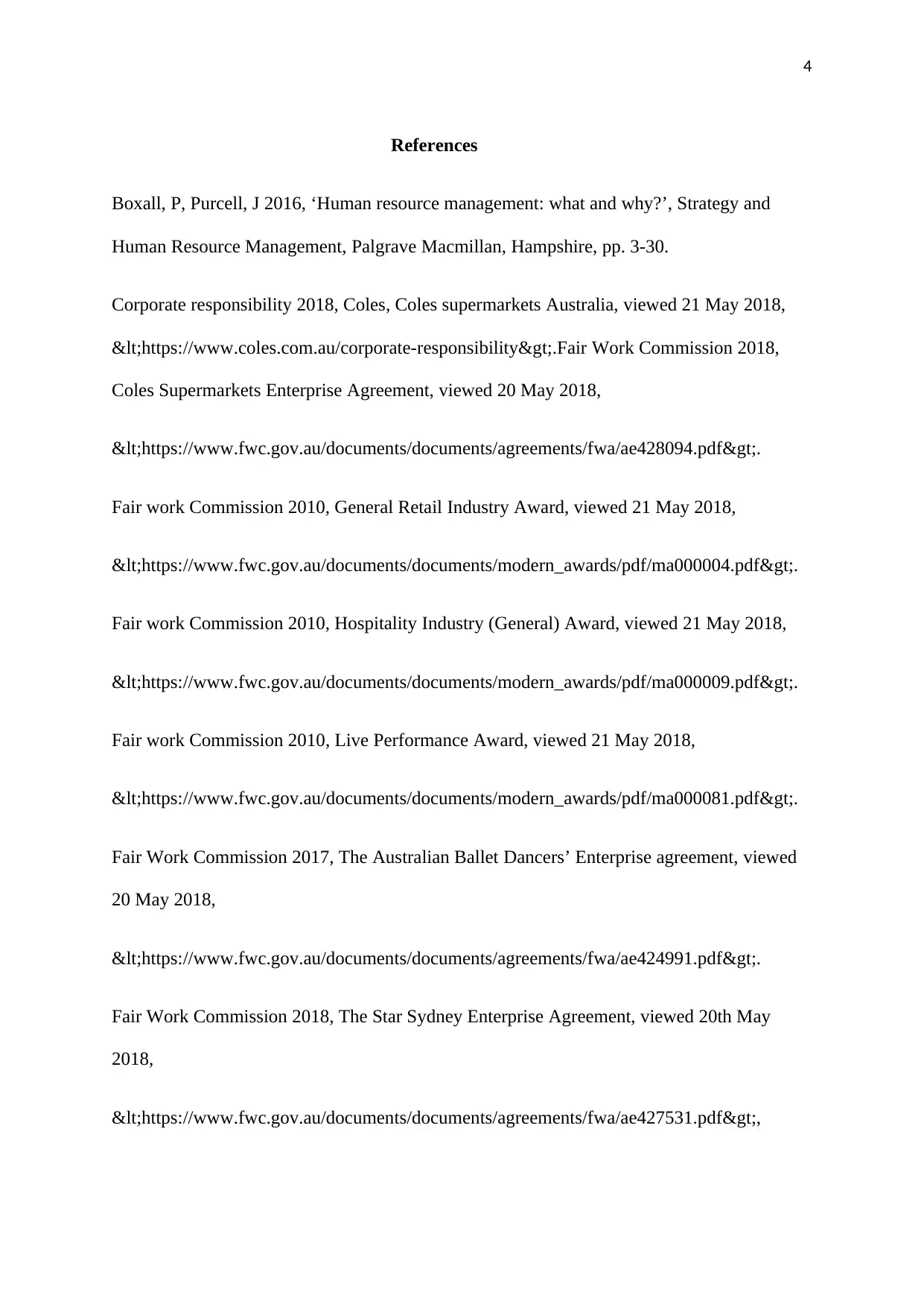
4
References
Boxall, P, Purcell, J 2016, ‘Human resource management: what and why?’, Strategy and
Human Resource Management, Palgrave Macmillan, Hampshire, pp. 3-30.
Corporate responsibility 2018, Coles, Coles supermarkets Australia, viewed 21 May 2018,
<https://www.coles.com.au/corporate-responsibility>.Fair Work Commission 2018,
Coles Supermarkets Enterprise Agreement, viewed 20 May 2018,
<https://www.fwc.gov.au/documents/documents/agreements/fwa/ae428094.pdf>.
Fair work Commission 2010, General Retail Industry Award, viewed 21 May 2018,
<https://www.fwc.gov.au/documents/documents/modern_awards/pdf/ma000004.pdf>.
Fair work Commission 2010, Hospitality Industry (General) Award, viewed 21 May 2018,
<https://www.fwc.gov.au/documents/documents/modern_awards/pdf/ma000009.pdf>.
Fair work Commission 2010, Live Performance Award, viewed 21 May 2018,
<https://www.fwc.gov.au/documents/documents/modern_awards/pdf/ma000081.pdf>.
Fair Work Commission 2017, The Australian Ballet Dancers’ Enterprise agreement, viewed
20 May 2018,
<https://www.fwc.gov.au/documents/documents/agreements/fwa/ae424991.pdf>.
Fair Work Commission 2018, The Star Sydney Enterprise Agreement, viewed 20th May
2018,
<https://www.fwc.gov.au/documents/documents/agreements/fwa/ae427531.pdf>,
References
Boxall, P, Purcell, J 2016, ‘Human resource management: what and why?’, Strategy and
Human Resource Management, Palgrave Macmillan, Hampshire, pp. 3-30.
Corporate responsibility 2018, Coles, Coles supermarkets Australia, viewed 21 May 2018,
<https://www.coles.com.au/corporate-responsibility>.Fair Work Commission 2018,
Coles Supermarkets Enterprise Agreement, viewed 20 May 2018,
<https://www.fwc.gov.au/documents/documents/agreements/fwa/ae428094.pdf>.
Fair work Commission 2010, General Retail Industry Award, viewed 21 May 2018,
<https://www.fwc.gov.au/documents/documents/modern_awards/pdf/ma000004.pdf>.
Fair work Commission 2010, Hospitality Industry (General) Award, viewed 21 May 2018,
<https://www.fwc.gov.au/documents/documents/modern_awards/pdf/ma000009.pdf>.
Fair work Commission 2010, Live Performance Award, viewed 21 May 2018,
<https://www.fwc.gov.au/documents/documents/modern_awards/pdf/ma000081.pdf>.
Fair Work Commission 2017, The Australian Ballet Dancers’ Enterprise agreement, viewed
20 May 2018,
<https://www.fwc.gov.au/documents/documents/agreements/fwa/ae424991.pdf>.
Fair Work Commission 2018, The Star Sydney Enterprise Agreement, viewed 20th May
2018,
<https://www.fwc.gov.au/documents/documents/agreements/fwa/ae427531.pdf>,
Paraphrase This Document
Need a fresh take? Get an instant paraphrase of this document with our AI Paraphraser
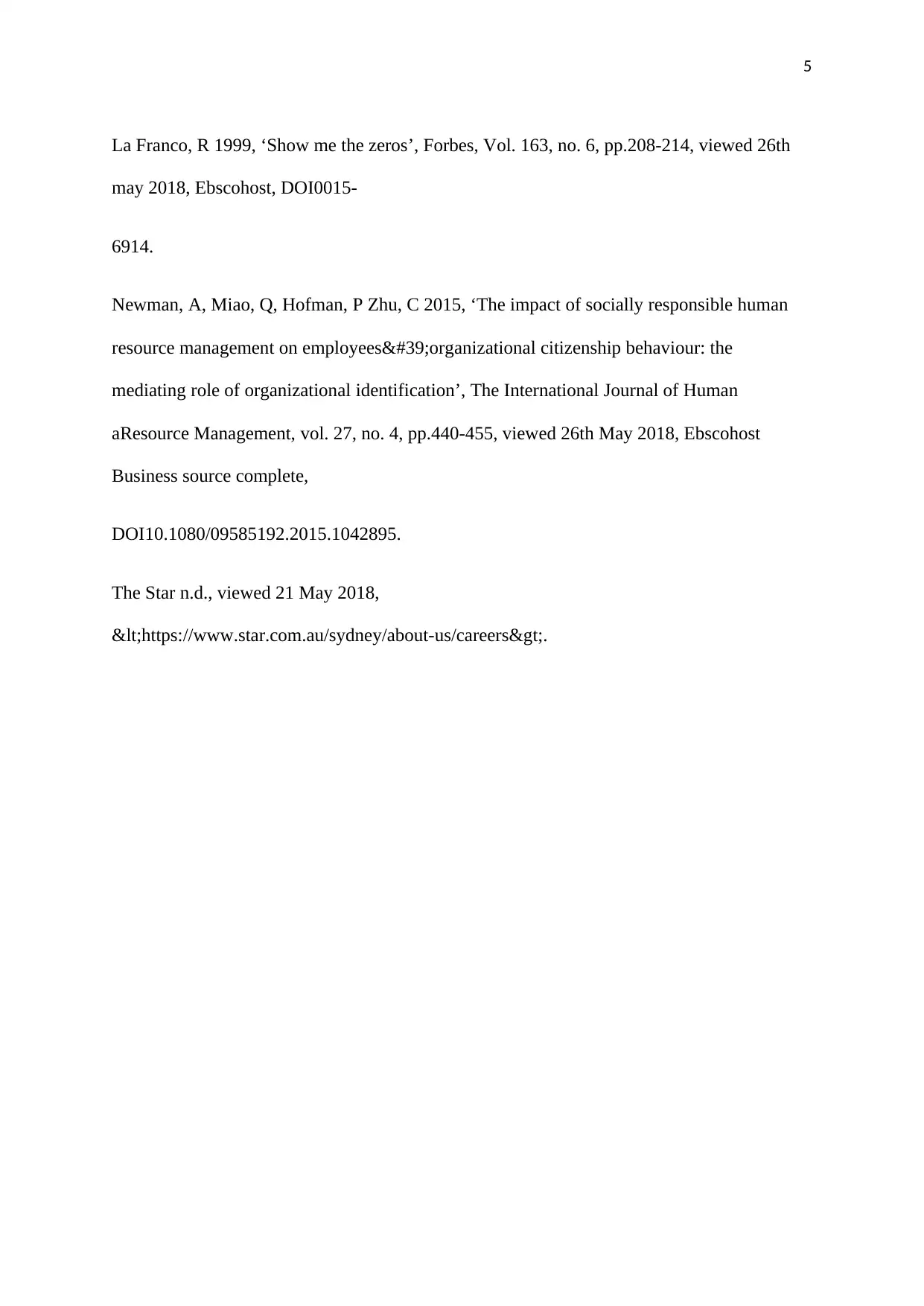
5
La Franco, R 1999, ‘Show me the zeros’, Forbes, Vol. 163, no. 6, pp.208-214, viewed 26th
may 2018, Ebscohost, DOI0015-
6914.
Newman, A, Miao, Q, Hofman, P Zhu, C 2015, ‘The impact of socially responsible human
resource management on employees'organizational citizenship behaviour: the
mediating role of organizational identification’, The International Journal of Human
aResource Management, vol. 27, no. 4, pp.440-455, viewed 26th May 2018, Ebscohost
Business source complete,
DOI10.1080/09585192.2015.1042895.
The Star n.d., viewed 21 May 2018,
<https://www.star.com.au/sydney/about-us/careers>.
La Franco, R 1999, ‘Show me the zeros’, Forbes, Vol. 163, no. 6, pp.208-214, viewed 26th
may 2018, Ebscohost, DOI0015-
6914.
Newman, A, Miao, Q, Hofman, P Zhu, C 2015, ‘The impact of socially responsible human
resource management on employees'organizational citizenship behaviour: the
mediating role of organizational identification’, The International Journal of Human
aResource Management, vol. 27, no. 4, pp.440-455, viewed 26th May 2018, Ebscohost
Business source complete,
DOI10.1080/09585192.2015.1042895.
The Star n.d., viewed 21 May 2018,
<https://www.star.com.au/sydney/about-us/careers>.
1 out of 5
Related Documents
Your All-in-One AI-Powered Toolkit for Academic Success.
+13062052269
info@desklib.com
Available 24*7 on WhatsApp / Email
![[object Object]](/_next/static/media/star-bottom.7253800d.svg)
Unlock your academic potential
Copyright © 2020–2025 A2Z Services. All Rights Reserved. Developed and managed by ZUCOL.
